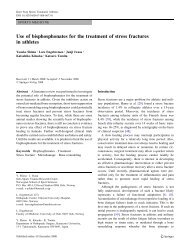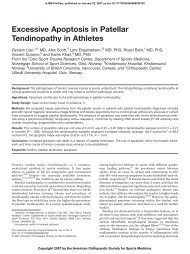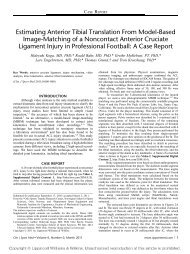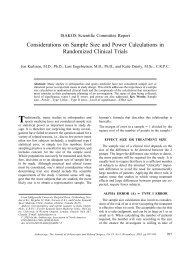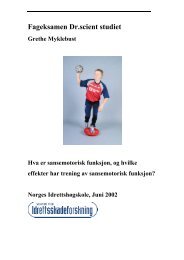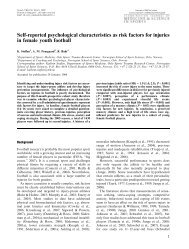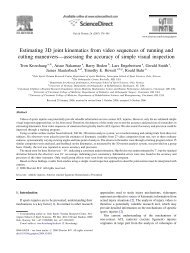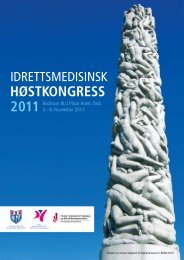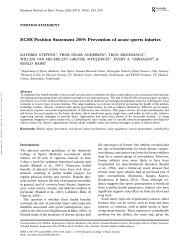The Anatomy of the Medial Part of the Knee
The Anatomy of the Medial Part of the Knee
The Anatomy of the Medial Part of the Knee
You also want an ePaper? Increase the reach of your titles
YUMPU automatically turns print PDFs into web optimized ePapers that Google loves.
2006<br />
THE JOURNAL OF BONE & JOINT SURGERY · JBJS.ORG<br />
VOLUME 89-A · NUMBER 9 · SEPTEMBER 2007<br />
T HE ANATOMY OF THE MEDIAL PART OF THE KNEE<br />
<strong>The</strong> distal-lateral aspect <strong>of</strong> <strong>the</strong> adductor magnus tendon<br />
had a very thick tendinous sheath that attached to <strong>the</strong><br />
medial supracondylar line. <strong>The</strong> vastus medialis obliquus muscle<br />
had its medial attachment both along this thick tendinous<br />
sheath and also along <strong>the</strong> lateral aspect <strong>of</strong> <strong>the</strong> adductor magnus<br />
tendon.<br />
<strong>Medial</strong> Gastrocnemius Tendon<br />
<strong>The</strong> medial gastrocnemius tendon was formed at <strong>the</strong> medial<br />
edge <strong>of</strong> <strong>the</strong> medial gastrocnemius muscle belly (Fig. 10). It attached<br />
an average <strong>of</strong> 2.6 mm (range, 1.4 to 4.4 mm) proximal<br />
and 3.1 mm (range, 2.6 to 3.6 mm) posterior in a depression<br />
adjacent to a third osseous prominence over <strong>the</strong> medial aspect<br />
<strong>of</strong> <strong>the</strong> medial femoral condyle, <strong>the</strong> gastrocnemius tubercle,<br />
and <strong>the</strong> tendon attachment was an average <strong>of</strong> 5.3 mm (range,<br />
4.0 to 7.2 mm) distal and 8.1 mm (range, 6.1 to 10.3 mm) posterior<br />
to <strong>the</strong> adductor tubercle (Figs. 2 and 10) (see Appendix).<br />
As noted previously, <strong>the</strong> medial gastrocnemius tendon<br />
had a thick fascial attachment along its lateral aspect to <strong>the</strong> adductor<br />
magnus tendon and a thin fascial attachment along its<br />
medial and posterior aspect to <strong>the</strong> capsular arm <strong>of</strong> <strong>the</strong> posterior<br />
oblique ligament.<br />
Pes Anserine Tendon Attachments<br />
<strong>The</strong> pes anserine tibial attachment consisted <strong>of</strong> <strong>the</strong> sartorius,<br />
gracilis, and <strong>the</strong> semitendinosus tendinous attachments on<br />
<strong>the</strong> anteromedial aspect <strong>of</strong> <strong>the</strong> proximal part <strong>of</strong> <strong>the</strong> tibia. <strong>The</strong><br />
sartorius tendon fascia was intimately attached to <strong>the</strong> superficial<br />
fascial layer, whereas <strong>the</strong> gracilis and semitendinosus<br />
tendons were located on <strong>the</strong> posterior (deep) surface <strong>of</strong> <strong>the</strong><br />
superficial fascial layer over <strong>the</strong> medial aspect <strong>of</strong> <strong>the</strong> knee.<br />
Once <strong>the</strong> pes anserine tendons were reflected laterally, <strong>the</strong>ir<br />
distinct individual attachment sites were easily identified as<br />
each individual tendon attached in an almost linear fashion<br />
at <strong>the</strong> lateral edge <strong>of</strong> <strong>the</strong> pes anserine bursa, which was<br />
present in all knees (Fig. 11). <strong>The</strong> sartorius tendon attached<br />
more proximally, followed by <strong>the</strong> gracilis tendon and <strong>the</strong><br />
semitendinosus tendon. <strong>The</strong> average tendon widths were 8.0<br />
mm (range, 5.7 to 9.3 mm) for <strong>the</strong> sartorius, 8.4 mm (range,<br />
6.2 to 11.4 mm) for <strong>the</strong> gracilis, and 11.3 mm (range, 7.5 to<br />
15.8 mm) for <strong>the</strong> semitendinosus at <strong>the</strong>ir tibial attachment<br />
sites. <strong>The</strong> midpoint <strong>of</strong> <strong>the</strong> lateral attachment <strong>of</strong> <strong>the</strong> gracilis<br />
on <strong>the</strong> tibia averaged 8.2 mm (range, 2.8 to 11.3 mm) proximal<br />
and 13.4 mm (range, 10.3 to 15.5 mm) anterior to <strong>the</strong><br />
distal osseous attachment <strong>of</strong> <strong>the</strong> superficial medial collateral<br />
ligament.<br />
Semimembranosus Tendon Tibial Attachments<br />
<strong>The</strong> semimembranosus tendinous attachments on <strong>the</strong> medial<br />
and posteromedial parts <strong>of</strong> <strong>the</strong> tibia consisted <strong>of</strong> <strong>the</strong> anterior<br />
and direct arms (see Appendix). <strong>The</strong> anterior arm attached<br />
deep to <strong>the</strong> proximal tibial attachment <strong>of</strong> <strong>the</strong> superficial medial<br />
collateral ligament in an oval-shaped pattern, and its attachment<br />
was distal to <strong>the</strong> tibial joint line. <strong>The</strong> direct arm<br />
attached to <strong>the</strong> proximal aspect <strong>of</strong> <strong>the</strong> posteromedial part <strong>of</strong><br />
<strong>the</strong> tibia in a small groove just proximal to <strong>the</strong> tuberculum<br />
Fig. 8<br />
Photograph <strong>of</strong> <strong>the</strong> isolated medial patell<strong>of</strong>emoral ligament (MPFL) with<br />
<strong>the</strong> posterior vastus medialis obliquus (VMO) fibers elevated <strong>of</strong>f <strong>the</strong> ligament<br />
(medial view, right knee). <strong>The</strong> needle driver is under <strong>the</strong> medial<br />
patell<strong>of</strong>emoral ligament, and <strong>the</strong> pointer is at <strong>the</strong> distal edge <strong>of</strong> <strong>the</strong><br />
medial patell<strong>of</strong>emoral ligament. <strong>The</strong> deeper medial capsule has been<br />
removed. AMT = adductor magnus tendon, p = patella, and SM = semimembranosus<br />
tendon.<br />
Fig. 9<br />
Photograph <strong>of</strong> <strong>the</strong> femoral attachment <strong>of</strong> <strong>the</strong> adductor magnus tendon<br />
(AMT) and its fascial expansion (arrows) to <strong>the</strong> medial gastrocnemius<br />
tendon (MGT) and posteromedial capsule (PMC) (medial view, right<br />
knee). <strong>The</strong> forceps is holding <strong>the</strong> anterior edge <strong>of</strong> superficial medial<br />
collateral ligament (sMCL). SM = semimembranosus tendon.



